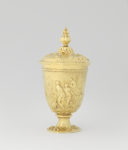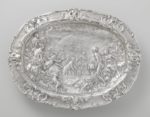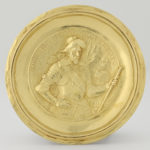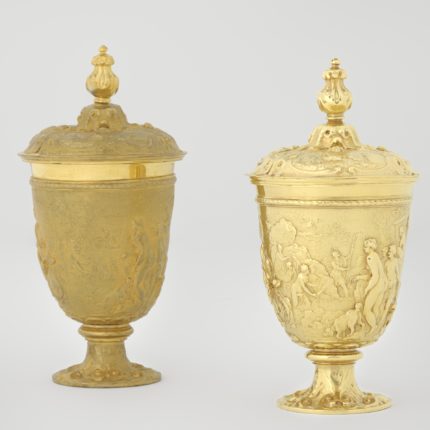 One of the Rijksmuseum’s most cherished dreams has come true with the long-term loan of a solid gold cup by the Netherlands’ most famous goldsmith Paul van Vianen.
One of the Rijksmuseum’s most cherished dreams has come true with the long-term loan of a solid gold cup by the Netherlands’ most famous goldsmith Paul van Vianen.
Paul van Vianen was the most important scion of a famous family of silversmiths from Utrecht, and he enjoyed star status in his lifetime. Subsequent generations of silversmiths looked to him as their primary source of inspiration, and artists collected his original works or copies of them. Rembrandt was among the artists
who owned plaster casts of objects made by him. Van Vianen ventured out into the great wide world at the age of 16, and he worked at several famous Central European courts before ultimately joining the Prague Royal Court of the Holy Roman Emperor Rudolph II, which he continued to serve until his death in May 1613.
The lid features the gods enacting a proverb from Terence’s comedy Eunuchus that “without Ceres and Bacchus, Venus freezes.” The metonym signifying that love needs food and wine to live was a popular motif in  Northern Mannerist art of the second half of the 16th and first half of the 17th century. It appeared in paintings, engravings and as prints in emblem books. Rubens was fond of the motif and painted several version of a chilly Venus needing to be warmed with the fruits of Ceres and Bacchus.
Northern Mannerist art of the second half of the 16th and first half of the 17th century. It appeared in paintings, engravings and as prints in emblem books. Rubens was fond of the motif and painted several version of a chilly Venus needing to be warmed with the fruits of Ceres and Bacchus.
The body of the cup depicts the myth of Diana and Actaeon, described by Ovid in Book III of his Metamorphoses. Actaeon comes across the Huntress bathing with her nymphs and an enraged Diana transforms  him into a stag. He flees and is devoured by his own hounds. Another work of Vianen’s on the same theme, a large silver basin made in 1613, was acquired by the Rijksmuseum in 1947. It shares design and composition elements with the cup, most notably the central figure of Actaeon beginning to sprout antlers.
him into a stag. He flees and is devoured by his own hounds. Another work of Vianen’s on the same theme, a large silver basin made in 1613, was acquired by the Rijksmuseum in 1947. It shares design and composition elements with the cup, most notably the central figure of Actaeon beginning to sprout antlers.
The cup was created in Prague in 1610 for Heinrich Julius, Prince of Brunswick-Wolfenbüttel. Heinrich Julius spent years at the court of  Rudolph II, enlisting the emperor’s aid in his struggle against the proudly independent burghers of Brunswick who were not even remotely interested in relinquishing 200 years of autonomy and bending the knee to their ostensible prince. There’s a portrait of the prince in full armour on the inside of the cup.
Rudolph II, enlisting the emperor’s aid in his struggle against the proudly independent burghers of Brunswick who were not even remotely interested in relinquishing 200 years of autonomy and bending the knee to their ostensible prince. There’s a portrait of the prince in full armour on the inside of the cup.
After Heinrich Julius’s death in 1613, the cup passed to his daughter Sophia Hedwig, wife of Count Ernest Casimir I of Nassau-Dietz. It spent the next two centuries as the greatest masterpiece in the collection of the Dutch royal family. In 1881 it was sold to a German collector, much to the Rijksmuseum’s dismay. The museum mourned its loss by crafting a gilt copper replica, a wan simulacrum of the original. Last year the gold cup was offered to the Rijksmuseum. The Wessels family bought it for them, so while the cup is still privately owned, it will be on public display at the Rijksmuseum in perpetuo.
